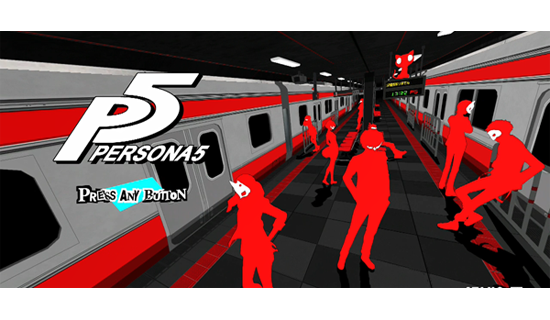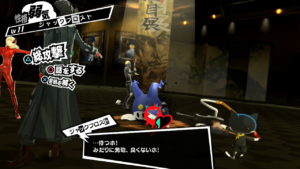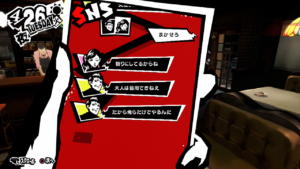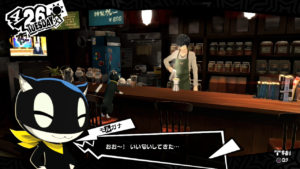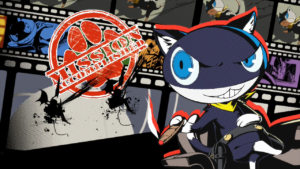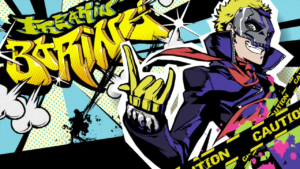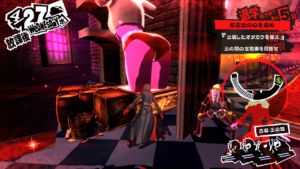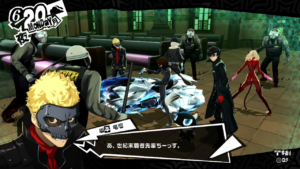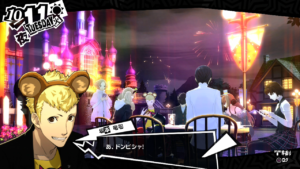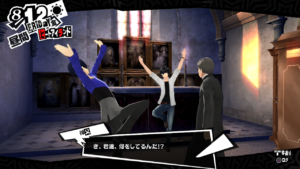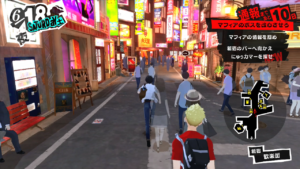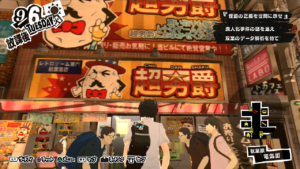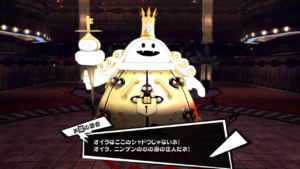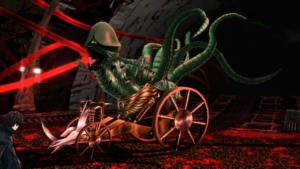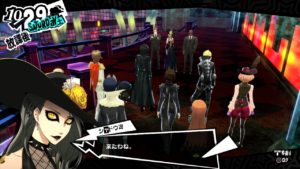An eight to ten year gap between mainline games in the Shin Megami Tensei family (Persona included) is not unusual. Persona 4 was a PlayStation 2 title released in 2008, basically two years into the life of the PlayStation 3. This odd release decision didn’t stop P4 from successfully continuing the Persona legacy of being a cult RPG favorite in the west, that the series had really maintained since 3. Persona 5 was almost released in the same way: It was announced for release on the PlayStation 3 in 2014 (the same year that the PlayStation 4 launched in Japan), but the following year saw the platform changed to both PlayStation 3 and PlayStation 4. We’ll never know how things would have gone for P5 if it had remained only on the PS3, in an era where it’s becoming an increasingly ridiculous idea for your average gamer to keep anything older than the current generation of console hardware hooked to their TV.
Upon first glimpses of game play, P5 was heavily praised for its design aesthetics, and just how exciting it looked. And rightfully so, because all of the usual Persona players are back: Director Katsura Hashino (Has been at the helm of the Persona series since P3, but had previously directed other SMT family games such as the Maken X series, SMT III and Digital Devil Saga: Avatar Tuner), Character Designer Shigenori Soejima (Well known for character designs on every Persona game since 3, as well as the SMT mainline remakes on the PlayStation and SMT III) and Sound Designer Shoji Meguro (Has been contributing to Atlus game soundtracks since Persona 1, but started composing on his own with P3). A new face this time around is the well known animation studio Production I.G, who is responsible for the animated cut scenes. The involvement of such a studio could be indicative of the sheer amount of excitement people felt for this game, in part due to a major difference from the time P4 was released: Internet culture.
The hype levels for popular games across message boards and social media platforms has gone through the roof in the eight years between Persona games, and streaming has also risen up as a big promotional tool to support that hype. Atlus took advantage of this with a series of streams in the year leading up to release that were maybe more slower paced than many would have liked, but still kept reminding people that Persona 5 was coming. They even doubled down on the fact that this was the first Persona game to take place in Tokyo (though this was a given for mainline Shin Megami Tensei games) by having the band of thieves that were the main characters “take” Tokyo Tower.
The downside to such a long time between releases and such high levels of hype though, is that you’re expected to deliver more than just a simple iteration of the last game, making sure to keep the things that everyone loved about it. Persona 5 managed to walk this line flawlessly. Walking and taking public transportation (or teleporting, depending on your choice) around Tokyo feels as good as it ever did in Inaba, and social links make a return as Co-Ops (apparently the official English phrase will be Confidants). Leveling up the Social Links of old would result in being able to fuse higher level Personas and get bonuses for Personas within that particular Link’s arcana, and Links with your teammates would result in them gaining access to new abilities. All of that is still the case with Co-Ops, but you can now gain various extra abilities when you level them up with characters who aren’t a part of your party. These abilities can range from nice to have to basically essential, so planning a path to the abilities you find most valuable is important. Interacting with your Co-ops has been made even easier, since they’ll typically contact you via the Line-esque app on your phone (called SNS) when they want to meet up with you. Status Parameters also return, and this time there are five: Knowledge, courage, dexterity, kindness, and charm. Many Co-Ops will require parameters to be at specific levels before being able to engage with that person, or being able to go past a certain level with them.
Persona 5 also offers many different ways to level up those parameters. You can work a choice of several different part-time jobs (these also have the benefit of earning you money), study, read (Yes this is separate from studying. There are many different books, and finishing them can level up attributes other than just knowledge), do crossword puzzles (No, you didn’t read that wrong), practice making coffee (This makes more sense once you get into the story), crafting tools for dungeons (Lock picks for treasure chests, etc.), grow vegetables, take baths, fish, go to a batting center, and even play retro games (Though there isn’t much in the way of actual interaction with the games themselves). Between all the things you can do to level up your parameters and leveling those Co-Ops, you might think that you already have too much to fill your time.
Well apparently that isn’t enough! In addition to the normal dungeons that must be cleared by certain dates in order to progress the story, there’s also a whole different continuous dungeon called Mementos. As you progress in the game you’ll hear about more minor events that need seeing to, and you can accept those events as missions that can be completed in Mementos. It also has ties to the story, though the pace at which you progress down into its depths is completely up to you. While it isn’t a procedurally generated dungeon like in Persona 3 and 4, you’re mapping the dungeon floors as you go through them, and it certainly isn’t as finely crafted as the story dungeons are. That’s right, no more procedurally generated story dungeons! They’re all very carefully and (for the most part) well designed this time around, which makes going through them a much more pleasant experience. A more stealthy style of play is also encouraged (you are thieves after all), so you’re given corners and various objects that you can hide from enemy view behind. If you take advantage of this, you’ll be able to get a surprise attack almost every time. This whole system only works because the enemies are no longer random spawns, but are now visible on the dungeon map ahead of time. This makes Persona 5 an example of all of the right things to do for dungeon design in a modern turn-based JRPG. Their designs tend to get a little too puzzle-y for my tastes as they get into the later dungeons. They’re never really frustrating because the puzzles are too hard to figure out, but rather because those puzzles make them take so much longer to get through than seems necessary.
Speaking of dungeons, let’s talk about the battle system. Persona series fans will find it very familiar, but it now features some elements that have been brought into Persona from the mainline Shin Megami Tensei games. In order to get demons into your Persona collection, you have to talk to them (the last time we saw this in a Persona game was with 2). Thankfully it isn’t quite as prone to disaster as it is it can be in the main SMT series, but the wrong choices in a conversation can lead them to either giving you an item and leaving, or getting angry and attacking you again. You can choose to talk to the demon, try to force them to give you money or items, or launch into an All-Out Attack when you have them in a state called “Hold Up” (You surround the demon and point your guns at them). This is usually achieved by exploiting their magic or weapon weaknesses, or just scoring a critical hit on them. Guns have also been brought in as a weapon type, and while they don’t necessarily do a ton of damage they can often be used to exploit weaknesses on flying enemies. Two new types of magic also return from the SMT series.
Though I was overwhelmed by some of them at first, I really ended up liking all of the additions that were made to both the battle system and list of ways to spend free time. The biggest draw of all ended up being the story though. All we knew about it going in was that the main characters were still high school students (with the exception of a talking cat named Morgana), but also a part of a group of thieves that “took hearts”. We also knew that here was a central theme of “being a slave”. But once you get into the game P5 not only starts off with a much bigger bang than previous installments (it begins in media res), but also quickly establishes that it’s going to explore much darker situations than its immediate predecessor. Most of the main story points can be directly mapped back to actual incidents that have occurred in Japan within recent years, and are not afraid to show characters in the depths of depression or pushed to their emotional limits. It shows that everyone (but especially those in prominent positions) is capable of being a shitty human being, but they’re also capable of change. This theme exists mostly to support the main theme though, which goes back to the hints at “being a slave” and a vague prison theme presented early on in the promotion of P5.
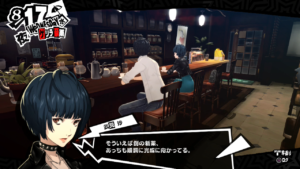
This is meant to point out how easy it is to become complacent in, and become a slave to or prisoner of the systems that make up adult life and societal rules. People sometimes get so worn down by these things that it’s easier to not want to make meaningful decisions in your life, and just sit back and let things happen with no recourse. That’s just the way things are after all, what can you do? Up until the last part of the game, this is exemplified through specific stories of people who have become corrupt and lost their way. But then the game clubs you over the head with its main theme during the final stretch, which feels a bit clumsy and unnecessary. Regardless, our main characters are established from the beginning as the antidote to this sort of behavior. Their costumes are physical manifestations of their wills to rebel, and when they’re pushed far enough to be able to form a bond with their Persona they gain the means to do so. The main characters being high school students works as more than just a JRPG crutch in this case too: They can feel this way because they’re still young and full of ideals. These themes resonated with me so much more than those of past Persona games, and that was a big factor in just how much I ended up enjoying the game.
The story being slightly too drawn out and ham-fisted near the end wasn’t its only issue. There was a fairly small but noticeable amount of unnecessary fan service sprinkled throughout the anime cut scenes in particular. Every instance seems to be centered around Ryuuji ogling Anne (No, this has nothing to do with Anne’s costume). There are closeup shots of sweat running down Anne’s chest, along with Ryuuji actually making grabby hands when Anne and Makoto come out in bathing suits during a beach scene. They don’t necessarily ruin everything and they’re over with just as quickly as they began, they just stand out as being particular strange additions. I don’t remember any equivalents from previous Persona titles (and if there were, they probably weren’t as awkward). I get it, high school kids are horny. But if you have a group of friends that includes both boys and girls, that sort of stuff can make some pretty awkward situations. Here it’s dismissed with barely any acknowledgement at all.
Now for one of the biggest highlights of a Persona game: The music. Shoji Meguro is a fantastic composer whose style can range from anywhere to the darker tracks that are more typical of the SMT series (he did help compose for SMT 3: Nocturne after all), to the distinctive poppy rock that was his house style for Persona 3 and 4. Meguro tunes within Persona games are known for featuring vocalists Yumi Kawamura (Persona 3) and Shihoko Hirata (Persona 4), along with rapper Lotus Juice (Persona 3 and 4). This time around Meguro brings in a new vocalist (Lyn), as seems to be Persona tradition. Unfortunately there do not seem to be any tracks featuring Lotus Juice. This might be because the general style of the soundtrack has changed up slightly. Meguro’s more pop tinged sound is somewhat cast aside in favor of tracks that are more soulful, while still retaining many of his signature touches. There are a lot fewer background vocals sprinkled throughout otherwise instrumental songs, so when you get a vocal track it really is a vocal track. We end up with very disco-y vocal tracks, battle music with heavy guitars and drums, and background music with equal parts tense and straight up blues-y pieces. This may not sound ideal to those in love with the Persona 3 and 4 soundtracks, but the soundtrack to 5 works for me in a big way. Meguro really won me over by leaning heavily on rock/blues style organ in so much of the background music. And I really can’t get enough of the instrumental version of “Life Will Change”.
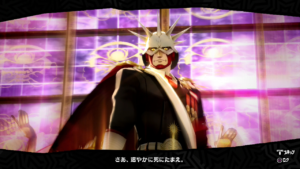
Persona 5 was so anticipated, it would have been very easy for it let everyone down. It exceeded my expectations, even as a fan of the series thus far, and I really feel like most others will feel the same way. 150 hours later, it probably will be the best game experience that I had in 2016. The series has always done a great job with making the player feel reluctant to leave that world by the end of the game, and P5 absolutely continues that. Having to go around and say goodbye to all of the Co-Ops that you maxed out at the end of the game is both incredibly happy and sad at the same time. And while the story is certainly not devoid of anime tropes (I don’t think the series ever will be), it’s easily the best written and thought out story that the modern series has seen so far. The mixture of light hearted moments and dark themes should cause anyone who would normally pass Persona over as being too “anime” to take a second look. Those who don’t care about stories and only want a battle system with some meat and plenty of content to work through won’t be disappointed either. If you’re thinking of taking on this game in Japanese prior to the English release, you should be warned though: It’s full of plenty of governmental and law vocabulary, and the difficulty level of conversation is significantly higher than I expected it would be. I spent a lot of time looking up words in a dictionary. But no matter what language it’s in, you owe it to yourself to play Persona 5 if you like JRPGs. It shows that Japan (or at the very least, Atlus) still can turn out the best that this genre has to offer.
